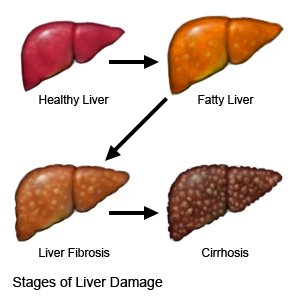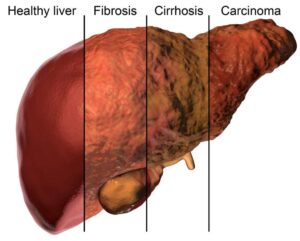Introduction
- What is Liver Fibrosis?
- Definition and basic understanding
- Importance of early detection
Understanding the Liver’s Role 2. Functions of a Healthy Liver
- Metabolism and detoxification
- Protein synthesis and digestion
- Storage of nutrients
Causes of Liver Fibrosis 3. Chronic Liver Diseases
- Hepatitis B and C
- Non-Alcoholic Fatty Liver Disease (NAFLD)
- Alcoholic liver disease
- Autoimmune and Genetic Factors
- Autoimmune hepatitis
- Genetic predispositions like Wilson’s disease
- Other Contributing Factors
- Environmental toxins
- Obesity and diabetes
- Long-term medication use
Progression of Liver Fibrosis 6. Stages of Liver Fibrosis
- Stage 1: Mild fibrosis
- Stage 2-3: Significant fibrosis and bridging
- Stage 4: Cirrhosis
- Fibrosis vs. Cirrhosis
- Differences between fibrosis and cirrhosis
- Reversibility of liver fibrosis
Symptoms and Diagnosis 8. Symptoms of Liver Fibrosis
- Early-stage symptoms
- Advanced-stage symptoms
- Diagnostic Tools and Tests
- Blood tests and liver function tests
- Imaging techniques: Ultrasound, CT scan, MRI
- Liver biopsy
Treatment Options 10. Lifestyle Changes and Management – Diet and exercise – Alcohol cessation
- Medical Interventions
- Antiviral treatments
- Antifibrotic agents
- Management of underlying conditions
Preventing Liver Fibrosis 12. Healthy Lifestyle Choices – Balanced diet rich in antioxidants – Regular exercise and weight management
- Regular Health Screenings
- Importance of routine check-ups
- Early intervention strategies
Living with Liver Fibrosis 14. Coping with Diagnosis – Mental and emotional well-being – Support groups and counseling
- Long-term Prognosis and Monitoring
- Regular monitoring and follow-up care
- Potential complications to watch out for
Conclusion 16. Summarizing Key Points – Importance of awareness and early detection – Encouragement to adopt preventive measures
FAQs
- What is the difference between liver fibrosis and cirrhosis?
- Can liver fibrosis be reversed?
- How long does it take for liver fibrosis to develop?
- What are the risk factors for liver fibrosis?
- Is liver fibrosis life-threatening?
Introduction
Liver fibrosis is a condition many might not be familiar with, yet it plays a critical role in liver health. This article aims to provide a comprehensive overview of liver fibrosis, exploring its causes, symptoms, and available treatment options. Understanding liver fibrosis is essential, as early detection and proper management can prevent serious complications, including cirrhosis and liver failure.
What is Liver Fibrosis?
Liver fibrosis refers to the excessive accumulation of scar tissue in the liver, which occurs when the liver tries to repair itself after injury. While the liver is known for its ability to regenerate, repeated damage—whether from chronic infections, toxins, or other factors—can lead to scarring. Unlike liver regeneration, fibrosis involves the formation of connective tissue, which can hinder liver function over time.
Understanding the Liver’s Role
To grasp the implications of liver fibrosis, it’s vital to first understand the liver’s fundamental role in the body.
Functions of a Healthy Liver
- Metabolism and Detoxification: The liver is central to metabolizing nutrients and detoxifying harmful substances. It processes everything from medications to alcohol and environmental toxins.
- Protein Synthesis and Digestion: The liver produces vital proteins, including those necessary for blood clotting, and aids in bile production, which is essential for digesting fats.
- Storage of Nutrients: The liver stores essential nutrients like vitamins and minerals, releasing them when the body needs them.
Causes of Liver Fibrosis
Liver fibrosis can result from various chronic liver conditions and other contributing factors.
Chronic Liver Diseases
- Hepatitis B and C: These viral infections are leading causes of liver fibrosis. Chronic inflammation from these viruses leads to progressive liver damage over time.
- Non-Alcoholic Fatty Liver Disease (NAFLD): NAFLD is linked to obesity and metabolic syndrome. It’s increasingly recognized as a major cause of liver fibrosis.
- Alcoholic Liver Disease: Excessive alcohol consumption over years can cause repeated liver injury, leading to fibrosis and eventually cirrhosis.
Autoimmune and Genetic Factors
- Autoimmune Hepatitis: The immune system mistakenly attacks liver cells, causing inflammation and fibrosis.
- Genetic Predispositions: Conditions like Wilson’s disease, where copper builds up in the liver, can also lead to fibrosis.
Other Contributing Factors
- Environmental Toxins: Long-term exposure to certain chemicals and toxins can damage the liver.
- Obesity and Diabetes: These conditions increase the risk of NAFLD and subsequent fibrosis.
- Long-term Medication Use: Some medications can cause liver damage if used over a prolonged period, contributing to fibrosis.
Progression of Liver Fibrosis
Liver fibrosis progresses through various stages, each with increasing severity.
Stages of Liver Fibrosis
- Stage 1: Mild Fibrosis: Minor scarring without significant impact on liver function.
- Stage 2-3: Significant Fibrosis: Scarring extends, affecting blood flow within the liver.
- Stage 4: Cirrhosis: Extensive scarring, leading to liver dysfunction and p
 otential liver failure.
otential liver failure.
Fibrosis vs. Cirrhosis
It’s important to distinguish between fibrosis and cirrhosis. While fibrosis is the buildup of scar tissue, cirrhosis is a severe form of fibrosis where normal liver tissue is replaced by nonfunctional scar tissue. Cirrhosis is often irreversible, whereas early-stage fibrosis can be managed and sometimes reversed.
Symptoms and Diagnosis
Liver fibrosis is often asymptomatic in its early stages, making diagnosis challenging.
Symptoms of Liver Fibrosis
- Early-Stage Symptoms: Fatigue, mild abdominal pain, and general weakness.
- Advanced-Stage Symptoms: Jaundice, significant abdominal swelling (ascites), and easy bruising or bleeding.
Diagnostic Tools and Tests
- Blood Tests and Liver Function Tests: These tests measure liver enzyme levels, which can indicate liver damage.
- Imaging Techniques: Ultrasounds, CT scans, and MRIs help visualize liver structure and detect fibrosis.
- Liver Biopsy: This invasive procedure is the most definitive way to assess the extent of liver fibrosis.
Treatment Options
Managing liver fibrosis requires addressing the underlying cause and preventing further damage.
Lifestyle Changes and Management
- Diet and Exercise: A healthy diet and regular physical activity are crucial in managing conditions like NAFLD.
- Alcohol Cessation: For those with alcoholic liver disease, quitting alcohol is essential to prevent further fibrosis.
Medical Interventions
- Antiviral Treatments: For hepatitis-related fibrosis, antiviral medications can reduce liver inflammation and prevent further scarring.
- Antifibrotic Agents: Emerging treatments aim to reduce fibrosis directly, though many are still in clinical trials.
- Management of Underlying Conditions: Controlling diabetes, obesity, or autoimmune diseases can slow fibrosis progression.
Preventing Liver Fibrosis
Prevention is the best strategy against liver fibrosis, involving both lifestyle and medical measures.
Healthy Lifestyle Choices
- Balanced Diet Rich in Antioxidants: Consuming fruits, vegetables, and whole grains helps protect the liver.
- Regular Exercise and Weight Management: Maintaining a healthy weight reduces the risk of NAFLD and related fibrosis.
Regular Health Screenings
Routine check-ups, especially for those at risk, are crucial. Early detection through regular screenings can lead to timely intervention, preventing the progression to cirrhosis.
Living with Liver Fibrosis
A diagnosis of liver fibrosis can be daunting, but with the right approach, many people manage the condition well.
Coping with Diagnosis
- Mental and Emotional Well-being: It’s normal to feel overwhelmed. Support groups and counseling can help navigate the emotional aspects of a liver fibrosis diagnosis.
- Support Groups and Counseling: Connecting with others facing similar challenges provides comfort and practical advice.
Long-term Prognosis and Monitoring
- Regular Monitoring and Follow-up Care: Frequent check-ups ensure the condition is under control and allow for timely adjustments in treatment.
- Potential Complications to Watch Out For: Being vigilant about symptoms that indicate progression to cirrhosis or liver failure is critical.

Conclusion
Liver fibrosis is a serious but manageable condition. By understanding its causes, recognizing early symptoms, and adopting a proactive approach to health, individuals can significantly reduce their risk of progression to cirrhosis. Awareness and early detection are key to maintaining liver health and preventing severe outcomes.
FAQs
- What is the difference between liver fibrosis and cirrhosis?
Liver fibrosis involves the buildup of scar tissue in the liver, while cirrhosis is an advanced stage of fibrosis with extensive scarring that impairs liver function. - Can liver fibrosis be reversed?
In its early stages, liver fibrosis can be reversed if the underlying cause is treated and further liver damage is prevented. - How long does it take for liver fibrosis to develop?
The timeline varies based on the cause. Chronic hepatitis or heavy alcohol use can lead to fibrosis over years, while acute liver injury can cause more rapid progression. - What are the risk factors for liver fibrosis?
Risk factors include chronic hepatitis B or C, excessive alcohol consumption, obesity, diabetes, and exposure to environmental toxins. - Is liver fibrosis life-threatening?
While early-stage fibrosis is manageable, if left untreated, it can progress to cirrhosis and liver failure, which are life-threatening.

